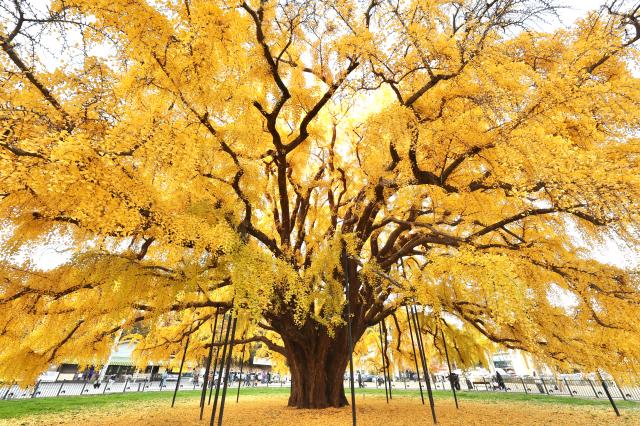
SEOUL, November 12 (AJP) - In Jangsu-dong, Incheon, and Banggye-ri, Gangwon Province, two ancient ginkgo trees stand as witnesses to time. Their vast canopies cast golden shadows across the ground, glowing under the thin autumn light.

The ginkgo in Jangsu-dong grows in the middle of the city. An overpass runs beside it, yet the tree holds its ground as if untouched by concrete and steel. The bark is coarse and timeworn, its surface cracked and uneven. Wooden pillars now support its enormous trunk, but its branches remain perfectly balanced, spreading outward in quiet symmetry.

From its base, multiple limbs diverge like rivers from a single source, shaping a dome of branches that seem deliberately composed. Designated as Natural Monument No. 562, the tree stands 28 meters tall, with a circumference of nearly 9 meters and an estimated age of about 800 years.

Beyond the low fence surrounding it, fallen leaves lie thick on the ground. Each gust of wind scatters them like yellow rain, and visitors lift their phones to capture the fleeting sight. Many have come deliberately for this — to see the tree at its brightest before winter dulls its color. The parking lot under the overpass fills easily, yet the crowd moves slowly, reverently, around the stillness of the tree.

At a distance, standing apart from the flow of people, the tree’s size and composure feel almost solemn. While everything moves and changes, it alone remains unmoved.

The ginkgo in Banggye-ri tells a different story. Standing before it, one feels age more than scale. Its massive trunk splits into thick limbs that stretch in every direction, some propped by supports. The surface is deeply creased, like folded fabric, and parts of its roots rise above the soil, tangled and exposed. From a distance, the tree resembles a cluster of trees rather than one.

When the wind blows, yellow leaves lift into the air all at once, and for a moment, the entire landscape falls still. Designated as Natural Monument No. 167, the Banggye-ri ginkgo is said to be around 1,300 years old, tracing its roots back to the Unified Silla period. Standing 26 meters high and more than 14 meters in girth, it towers above the surrounding rice fields, a solitary figure in open land.

For centuries, villagers have regarded it as sacred. Old tales speak of a white serpent that once lived beneath its roots — a spirit said to guard the tree. No one dared to cut or harm it, and through storms, droughts, and the slow touch of time, it has survived. To stand before it is to feel not sentiment, but awe — the weight of endurance itself.

The small parking area often overflows, a quiet proof of how many come to see it.

Leaving both trees behind, one remembers Jangsu-dong for its balance and stillness, and Banggye-ri for its scale and history. The first shows how nature can endure within a city; the second, how humankind grows smaller before the passing of time. At the edge of November, as yellow leaves drift through the cold air, both trees meet the same season again — as they have for centuries.
Copyright ⓒ Aju Press All rights reserved.




